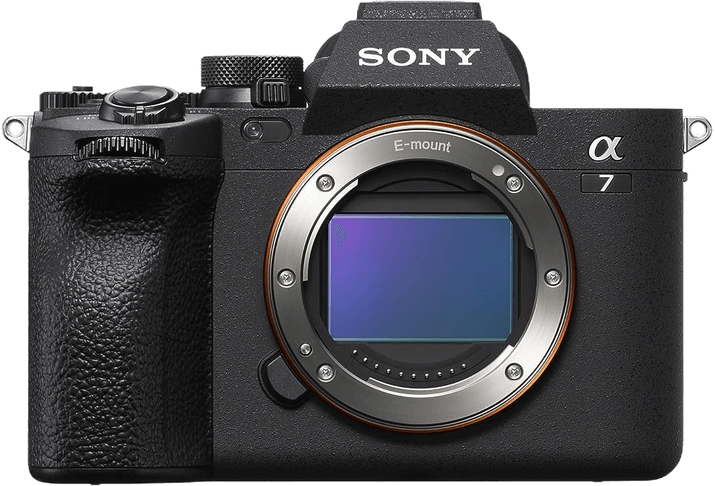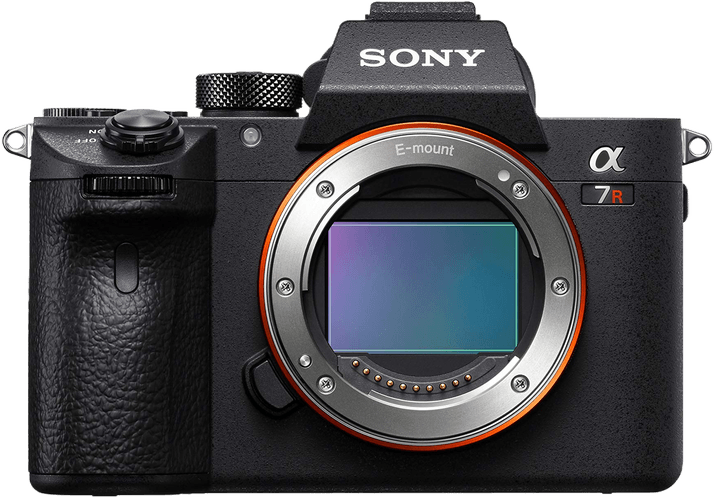Sony a7 IV vs a7R III Comparison
Sony a7 IV

Sony a7R III

The Sony a7 IV outperforms the Sony a7R III by a slim margin, scoring 84/100 compared to the a7R III’s 83/100. Both cameras are mirrorless and share similar dimensions, with the a7 IV measuring 131 x 96 x 80mm and the a7R III at 127 x 96 x 74mm. They also have almost identical weight—659g for the a7 IV and 657g for the a7R III.
The a7 IV’s higher score is due to its more recent release in 2021, compared to the a7R III’s 2017 release. Additionally, the a7 IV has a lower launch price of $2499, making it more cost-effective than the a7R III, which debuted at $3200.
The a7R III, however, is slightly more compact and lighter than the a7 IV, making it a bit more portable. Despite the minor differences, both cameras offer excellent performance and quality. The choice between them ultimately depends on individual preferences for pricing and portability.
Sony a7 IV vs a7R III Overview and Optics
The Sony a7 IV wins the optics comparison with a score of 85/100, while the Sony a7R III follows closely with a score of 84/100. Both cameras share several specifications, such as a 10 fps shooting speed, CMOS sensor type, full-frame sensor size, Sony FE lens mount, and image stabilization.
The a7 IV has a 33-megapixel sensor and a Bionz XR processor, which contributes to its higher optics score. Additionally, it has a DXOMARK sensor score of 97, which is slightly lower than the a7R III but still impressive. With these features, the a7 IV provides excellent image quality, faster processing, and better overall performance.
On the other hand, the a7R III has a higher 42.4-megapixel sensor and a DXOMARK sensor score of 100, which means it can capture more detail in images. However, its Bionz X processor is not as advanced as the a7 IV’s Bionz XR, which may affect the camera’s overall performance and speed.
While the a7 IV wins the optics comparison, the a7R III’s higher megapixel count and DXOMARK sensor score make it a strong competitor, especially for photographers who prioritize capturing intricate details in their images. Nevertheless, the a7 IV’s superior processor and overall performance give it a slight edge in the optics department.
In the end, the choice between the Sony a7 IV and the Sony a7R III will depend on the individual photographer’s priorities. If you value speed, processing power, and overall performance, the a7 IV is the better option. However, if capturing detailed images is your top priority, the a7R III may be the more suitable choice.
Sony a7 IV vs a7R III Video Performance
The Sony a7 IV emerges as the superior camera for video capabilities with a score of 91/100, significantly outperforming the Sony a7R III, which scores 56/100. Both cameras share some common specifications, including a maximum video resolution of 4K and maximum video dimensions of 3840 x 2160.
The Sony a7 IV excels in video performance due to its higher maximum video frame rate of 120fps, allowing for smoother slow-motion footage and increased creative flexibility. Additionally, the a7 IV has built-in time-lapse functionality, enabling users to create stunning time-lapse sequences without the need for external software or hardware.
While the Sony a7R III also offers 4K video resolution and the same maximum video dimensions, its maximum video frame rate is limited to 30fps. This lower frame rate restricts the camera’s ability to capture smooth slow-motion footage compared to the a7 IV. Furthermore, the a7R III lacks built-in time-lapse functionality, requiring users to rely on external tools or software to create time-lapse sequences.
Despite these shortcomings, the Sony a7R III still delivers high-quality 4K video footage, making it a viable option for those who do not require advanced video features such as high frame rates and built-in time-lapse functionality.
To conclude, the Sony a7 IV offers superior video capabilities, demonstrated by its higher video score, faster maximum video frame rate, and built-in time-lapse functionality. The Sony a7R III, while lacking advanced features, remains suitable for users who prioritize image quality and do not require the additional video capabilities provided by the a7 IV.
Sony a7 IV vs a7R III Features and Benefits
The Sony a7 IV and Sony a7R III both have a feature score of 83/100, making them equally competitive in terms of features. These cameras share many specifications, including a 3-inch touchscreen, flip screen, Wi-Fi, and Bluetooth capabilities. Neither camera has GPS functionality.
Despite having the same feature score, the Sony a7 IV has a lower screen resolution of 1,040,000 dots compared to the a7R III’s 1,440,000 dots. This means that the a7R III provides a sharper, more detailed display for users. However, this advantage may not be significant for some photographers, as both cameras still offer high-quality displays.
On the other hand, the Sony a7 IV excels in other aspects that may not be reflected in the feature score. It is essential to consider these factors when choosing between the two cameras. Some users may prioritize other specifications or performance aspects over the screen resolution difference.
In comparing the Sony a7 IV and Sony a7R III, it is clear that both cameras offer impressive features and capabilities. The choice between the two ultimately depends on individual preferences and priorities. While the a7R III has a higher screen resolution, the a7 IV may still be a better fit for some photographers, based on other factors not mentioned in this comparison. It is crucial for potential buyers to research and consider all aspects of each camera before making a decision.
Sony a7 IV vs a7R III Storage and Battery
The Sony a7 IV outperforms the Sony a7R III in storage and battery with a score of 76/100 compared to 65/100. Both cameras share common specifications, such as two memory card slots, compatibility with UHS-II cards, and the NP-FZ100 battery type.
The a7 IV excels with its support for CFexpress Type A cards, providing faster read and write speeds, and USB charging capability, offering convenient charging options. These advantages make the a7 IV more versatile and user-friendly for photographers and videographers.
On the other hand, the a7R III boasts a slightly longer battery life, reaching 650 shots versus the a7 IV’s 580 shots. This advantage may appeal to those who prioritize longer shooting sessions without the need for frequent battery replacements.
Taking these factors into account, the Sony a7 IV emerges as the superior option in terms of storage and battery, providing enhanced memory card compatibility and charging options. The Sony a7R III’s advantage in battery life may be appealing to some users, but it does not outweigh the benefits offered by the a7 IV.
Sony a7 IV vs a7R III Alternatives
Still not sure which camera is best for you? Check out some more popular camera comparisons for inspiration:
